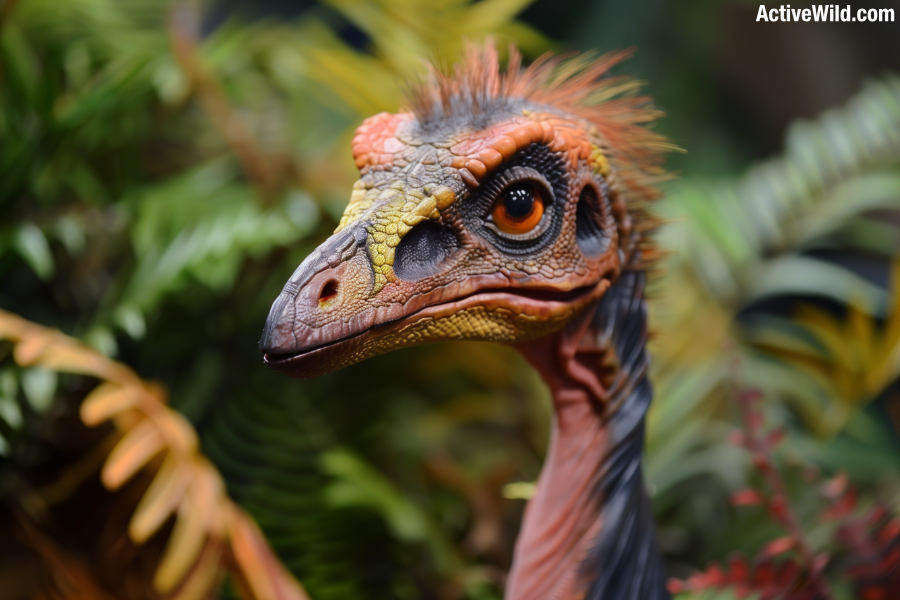
Oviraptor was a small theropod dinosaur that lived in Asia during the Late Cretaceous period. Discovered in the Gobi Desert around a century ago, Oviraptor was given the name “egg thief”, as it was found alongside some fossilized eggs. The dinosaur is now believed to have been brooding the eggs, rather than stealing them.
As well as its probable nesting behavior, Oviraptor had other bird-like features such as a toothless beak and a covering of feathers.
Read on to find out more about this distinctive Cretaceous dinosaur…
Oviraptor Facts
- Type of Dinosaur: Theropod
- Diet: Omnivore
- Continent(s) Found: Asia (specifically Mongolia)
- Length: Approximately 1.5 to 2 meters (5 to 6.5 feet)
- Weight: Around 33 kilograms (73 pounds)
- Period: Late Cretaceous (about 85 to 75 million years ago)
What Did Oviraptor Look Like?

Oviraptor was a small to medium-sized theropod dinosaur, typically measuring around 1.5 to 2 meters (5 to 6.5 feet) in length and weighing approximately 20 to 33 kilograms (44 to 73 pounds).
This small dinosaur had a distinctive appearance, with a short, toothless beak and probably a crest on its head, which likely varied in shape and size among different species.
The body was relatively lightweight and agile, supported by strong, slender legs, suggesting Oviraptor was a quick and nimble runner. Its forelimbs were well-developed, ending in three-fingered hands with sharp claws for grasping and manipulating objects. The tail was relatively short, and likely ended in a fan of feathers similar to that of a modern bird.
Evidence from fossilized remains and related species indicates that Oviraptor had a covering of feathers, adding to its bird-like appearance.
What Does The Name Oviraptor Mean?
The name “Oviraptor” means “egg thief.” This name was given because the first fossilized remains of Oviraptor were found near a nest of eggs, leading paleontologists to initially believe that it was stealing and eating the eggs.
However, later evidence suggested that Oviraptor might have been brooding the eggs rather than preying on them. Despite this new understanding, the name “egg thief” has persisted.
What Type Of Dinosaur Was Oviraptor?

Oviraptor was a theropod dinosaur belonging to the family Oviraptoridae. Theropods are typically characterized by their bipedal stance, hollow bones, and three-toed limbs.
Oviraptorids were a unique group within this larger classification, known for their distinctive, bird-like physical features and behaviors.
Oviraptorids, including Oviraptor, were generally small to medium-sized dinosaurs with a range of unique adaptations. They had short, beak-like jaws without teeth, though some species had a few teeth at the back of the jaw.
The skulls of oviraptorids often bore prominent crests of varying shapes and sizes, which may have been used for display or species recognition. Their limbs were well-developed, with strong, slender legs suggesting they were agile runners.
Fossil evidence indicates that Oviraptorids, including Oviraptor, were likely feathered, adding to their bird-like appearance. The presence of possible brooding behavior in Oviraptorid fossils suggests that they might have cared for their young similarly to modern birds.
You can find out more about the different types of dinosaurs on this page: Types Of Dinosaurs
The Discovery Of Oviraptor
In 1923, paleontologist Roy Chapman Andrews and his team uncovered the first Oviraptor fossil in the Gobi Desert in Mongolia. The fossil was discovered in the region’s Djadochta Formation.
The specimen was found on a nest of around 15 fossilized eggs, leading paleontologists to believe the dinosaur was stealing and eating the eggs. This assumption led to the naming of the genus “Oviraptor,” which is derived from the Latin for “egg thief”.
The type species, Oviraptor philoceratops, was formally described by Henry Fairfield Osborn in 1924. Subsequent findings and studies, including fossilized evidence suggesting that Oviraptor was likely brooding the eggs rather than preying on them, have challenged the initial interpretation, but the name “Oviraptor” has remained.
When Did Oviraptor Live?
Oviraptor lived during the Late Cretaceous period, approximately 85 to 75 million years ago.
What Dinosaurs And Other Animals Did Oviraptor Live With?
Oviraptor likely lived alongside a variety of other dinosaur species during the Late Cretaceous period in what is now Mongolia, particularly in the Gobi Desert region. Some of the notable dinosaurs that shared its habitat include:
- Protoceratops: A small, herbivorous ceratopsian dinosaur. Fossils of Protoceratops have been found in close association with Oviraptor, suggesting they shared the same environment.
- Velociraptor: A small, agile, carnivorous theropod. Velociraptor is well-known for its role in popular culture and was a contemporary predator in the same region.
- Therizinosaurus: A large theropod with long, clawed forelimbs, known for its herbivorous diet.
- Saurolophus: A large, herbivorous hadrosaur (duck-billed dinosaur). These dinosaurs were common in the Late Cretaceous and would have been part of the same ecosystem.
- Tarbosaurus: A large, carnivorous theropod similar to Tyrannosaurus rex. Tarbosaurus was one of the apex predators in the region.
Discover More About Dinosaurs With Active Wild
Visit our main dinosaur page for dinosaur facts, pictures, in-depth information and lists: Dinosaurs – The Complete Guide
The post Oviraptor Facts & Pictures: Complete Guide To A Cretaceous Period Dinosaur appeared first on Active Wild.